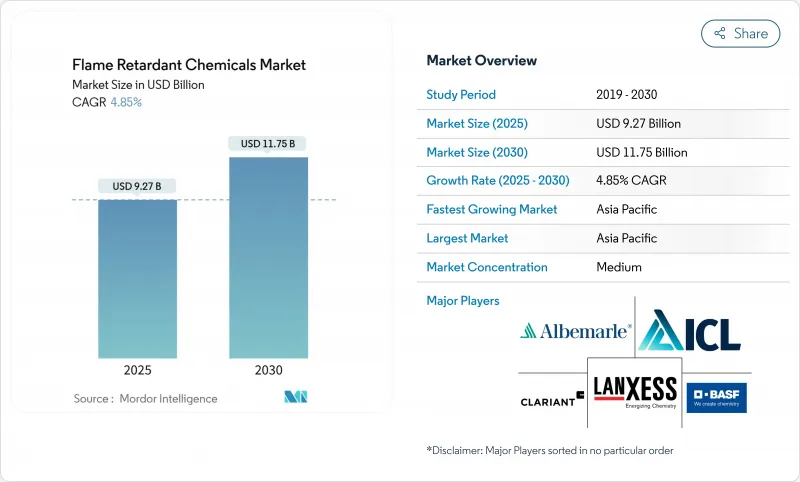
|
市場調査レポート
商品コード
1850193
難燃性化学品:市場シェア分析、産業動向、統計、成長予測(2025年~2030年)Flame Retardant Chemicals - Market Share Analysis, Industry Trends & Statistics, Growth Forecasts (2025 - 2030) |
||||||
カスタマイズ可能
適宜更新あり
|
|||||||
| 難燃性化学品:市場シェア分析、産業動向、統計、成長予測(2025年~2030年) |
|
出版日: 2025年06月24日
発行: Mordor Intelligence
ページ情報: 英文 120 Pages
納期: 2~3営業日
|
概要
難燃性化学品市場の2025年の市場規模は92億7,000万米ドルで、2030年には117億5,000万米ドルに達し、CAGR 4.85%で成長すると予測されています。

非ハロゲン系ソリューションを支持する規制の勢い、エネルギー効率の高い建物の建設増加、電気安全基準の厳格化がこの軌道を支えています。臭素系化合物が規制当局に受け入れられなくなったとしても、アジア太平洋地域で拡大する電子機器製造と自動車の電動化がベースライン需要を支えています。リンを主成分とする無機ポートフォリオを早期に拡大した生産者は、現在、プレミアム価格と優先サプライヤーとしての地位から利益を得ています。一方、アンチモンやリンのような重要鉱物の価格変動はマージンリスクをもたらし、難燃性化学品市場における現地調達戦略の価値を高めています。
世界の難燃性化学品市場の動向と洞察
厳しい火災安全規制が市場拡大を促進
2024年の国際建築基準法(International Building Code)の更新により、外壁アセンブリと発泡プラスチック断熱材に関する規制が強化され、難燃性負荷の高い建築材料の再製造が余儀なくされました。英国では、2026年9月から改正Approved Document Bが施行される予定で、このコンプライアンス向上動向はさらに強化されます。非ハロゲン製品ラインを販売するメーカーは現在、建築家や建設業者が発煙毒性試験やリサイクル性試験をクリアする配合を指定するため、強力な引き抜きに直面しています。欧州では高層ファサードの改修が相次ぎ、交換需要が拡大する一方、保険業者は保険料を認定された難燃性能と結びつけ、難燃性化学品市場の安定成長を支えています。
アジア太平洋のインフラ・ブームが需要を加速
中国では、鉄道回廊、データセンター、電池工場などの公共事業パイプラインが、難燃性ポリオレフィンとポリウレタン断熱材の購入を支えています。クラリアントは、広東省の2つのハロゲンフリー工場に1億スイスフランを投資し、長期的な需要への自信を示しています。中国、韓国、インドで組み立てられる電気自動車は、バッテリーケーシングとワイヤーハーネス用に1台あたり約1kgの難燃剤を必要とします。インドの100の市町村にまたがるスマートシティ・プログラムでは、新しい国家建築基準法の防火テストを満たさなければならない公共住宅プロジェクトが追加されます。これらの要因が相まって、アジア太平洋地域の難燃性化学品市場のCAGRは世界平均を上回っています。
規制上の制約が従来の化学物質を抑制
欧州化学品庁は、2025年2月の評価で芳香族臭素系難燃剤を難分解性、生物蓄積性、有毒であるとしました。ストックホルム条約に基づく並行協議では、デクロラン・プラスを残留性有機汚染物質としてリストアップすることを目指しており、電気製品への使用が禁止される可能性が高いです。レガシー臭素混合物の生産者はポートフォリオの見直しを余儀なくされ、暫定的な収益格差が生じて難燃性化学品市場の成長が抑制されます。
セグメント分析
非ハロゲン系化学物質は2024年に64.94%の市場シェアを占め、CAGR 5.02%で推移しています。建築基準法に準拠した新しい複合パネルの大部分は、リン酸系浸透剤と水酸化金属が占めています。クラリアントは中国でのExolit生産能力を倍増させ、アジアのコンバーターのリードタイムを短縮し、同地域の難燃性化学品市場をさらに定着させました。
ハロゲン系ブレンドは、低添加性という点では依然として評価されているもの、仕様の縮小に直面しています。アルベマールは、特定の臭素化グレードはライフサイクルの温室効果ガス強度が低く、最小限の脱臭処理でリサイクルできると主張しています。大手メーカーは、溶出と職場暴露を削減するカプセル化臭素の設計を実験的に採用し、その地位を維持しています。こうした技術革新の成否が、ハロゲン化スライスがより広範な難燃性化学品市場において防衛可能なニッチを維持するかどうかを決定することになります。
地域分析
アジア太平洋地域が2024年の難燃性化学品市場の50.55%を占め、2030年までのCAGRは5.56%です。中国は依然として世界の電子機器組立の中心地であり、難燃性のケーブルや絶縁体を必要とするデータセンターや送電網のインフラに多額の投資を行っています。バッテリー電気自動車製造に対する政府の刺激策が、モジュール、パック、インバーターにおける高性能ポリマーの需要を下支えしています。クラリアント、ICL、各地域のコンパウンドメーカーによる現地での生産能力増強は、サプライチェーンの短縮と輸送コストの抑制につながり、地域競争力を強化します。
北米は成熟しているが安定した市場です。2024年の国際建築基準法の改正により、断熱材とファサードシステムに高い難燃性が要求され、緩やかな成長が維持されます。消防用具や家電製品における州レベルのPFAS禁止令は、リンと窒素溶液への代替を加速させる。しかし中国のアンチモン輸出規制が添加剤コストを押し上げ、輸入三酸化アンチモンに依存する米国マスターバッチ・メーカーの利幅を圧迫しています。カナダの建築用エンベロープの改修とメキシコの自動車組立の伸びが引き続き数量を吸収しています。
欧州は世界で最も厳しい火災安全法と化学物質持続可能法に支えられ、安定した需要を示しています。英国の外壁システムに関する新しい規則は、ハロゲンフリーのアルミニウム水酸化物をベースとする噴気性塗料の使用を促進しています。ドイツの自動車部門では、循環型経済の目標に沿い、リサイクル可能な難燃性PPやポリアミドグレードの指定が増えています。ノルトリート(NORDTREAT)のような北欧のイノベーターはバイオベースの代替品を開発し、難燃性化学品市場の欧州スライスに差別化されたニッチを加えています。
その他の特典:
- エクセル形式の市場予測(ME)シート
- 3ヶ月のアナリストサポート
よくあるご質問
目次
第1章 イントロダクション
- 調査の前提条件と市場の定義
- 調査範囲
第2章 調査手法
第3章 エグゼクティブサマリー
第4章 市場情勢
- 市場概要
- 市場促進要因
- 建築・建設における厳格な火災安全規制
- アジア太平洋地域における急速なインフラ整備
- 家電製品および電気製品の生産量の増加
- 熱可塑性プラスチックと複合材料の使用増加
- ESGコンプライアンスのための非ハロゲンソリューションへの移行
- 市場抑制要因
- 臭素化/ハロゲン化化学物質に対する規制の抑制
- 原材料費の変動
- ナノ金属水酸化物の新たな毒性調査
- リン鉱石供給のボトルネック
- バリューチェーン分析
- 原材料分析
- 規制情勢
- テクノロジーの展望
- ポーターのファイブフォース
- 供給企業の交渉力
- 買い手の交渉力
- 新規参入業者の脅威
- 代替品の脅威
- 競合の程度
第5章 市場規模と成長予測
- 製品タイプ別
- 非ハロゲン系難燃剤
- 無機
- 水酸化アルミニウム
- 水酸化マグネシウム
- ホウ素化合物
- リン
- 窒素
- その他の製品タイプ
- ハロゲン系難燃剤
- 臭素化合物
- 塩素化合物
- 非ハロゲン系難燃剤
- 用途別
- ポリオレフィン
- PVC
- エポキシ樹脂
- エンジニアリング熱可塑性プラスチック(PA、PBT、PEEKなど)
- 不飽和ポリエステル樹脂
- ポリウレタン
- エンドユーザー業界別
- 電気・電子工学
- 建築・建設
- 交通機関
- 繊維と家具
- 地域別
- アジア太平洋地域
- 中国
- インド
- 日本
- 韓国
- その他アジア太平洋地域
- 欧州
- ドイツ
- 英国
- フランス
- イタリア
- その他欧州地域
- 北米
- 米国
- カナダ
- メキシコ
- 南米
- ブラジル
- アルゼンチン
- その他南米
- 中東・アフリカ
- サウジアラビア
- 南アフリカ
- その他中東・アフリカ地域
- アジア太平洋地域
第6章 競合情勢
- 市場集中度
- 戦略的動向
- 市場シェア(%)/ランキング分析
- 企業プロファイル
- Adeka Corporation
- Albemarle Corporation
- BASF
- Clariant AG
- DIC Corporation
- Dow Inc.
- Eti Maden
- ICL Group
- Italmatch Chemicals SpA
- J.M. Huber Corp.(Huber Engineered Materials)
- LANXESS AG
- Martin Marietta
- MPI Chemie BV
- Nabaltec AG
- Nyacol Nano Technologies Inc.
- RIN KAGAKU KOGYO Co. Ltd
- RTP Company
- Sanwa Chemical Co. Ltd
- Showa Denko K.K.
- Sibelco NV(Specialty Alumina)
- Thor Group
- Tosoh Corporation
- UFP Industries Inc.


